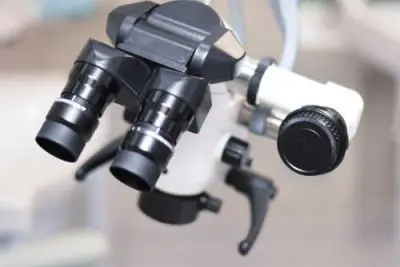Treatment of tooth canals

Toothache is most often associated with issues such as pulpitis (inflammation of the tooth’s vascular-nerve bundle) or periodontitis (disease of the tissues surrounding the tooth root). To treat this condition, the dentist needs to perform mechanical preparation (widening and cleaning), antiseptic treatment (disinfection), and canal filling. Modern treatment technologies using a microscope make the procedure as effective as possible.
In cases of diseases such as pulpitis or periodontitis, it is necessary to thoroughly treat the root canal(s) and, after ensuring there is no infection, seal them. The complexity of the treatment lies in the fact that the number and configuration of root canals do not always correspond to the number and shape of the roots themselves. Root canals may have a curved shape, branch out, or two parallel canals may run within one root. This complicates the treatment, as it is necessary to clean and fill all the canals in case of inflammation.
To understand their location within the tooth, a CT scan is performed beforehand, and working under a microscope ensures high-quality treatment.
Root canal treatment is carried out under anesthesia. The tooth cavity is opened, providing the dentist access to the pulp (soft tissue containing blood vessels, lymphatic vessels, and nerves), which is then removed. The cleaned root canal is treated with medication, dried, and then sealed with a filling.
When treating complicated forms of caries (tooth pulpitis, periodontitis), special attention is given to the quality of root canal passage and sealing – endodontic treatment. The canals are treated with ultrasound, which enhances treatment quality. The process is meticulously controlled, with X-ray monitoring performed at each stage.
We ensure a high level of sanitary safety: all consumables are disposable, and instruments undergo thorough disinfection and sterilization, eliminating the risk of infection.
Modern therapeutic methods and techniques, as well as the latest dental materials and tools, allow for high-quality, effective, and painless dental treatment.
In our work, when treating complicated forms of caries such as periodontitis, which involves an inflammatory process at the root tip (granuloma, cystogranuloma, cyst), we adhere to tooth-preserving techniques. In addition to mechanical, medicinal, and ultrasonic root canal treatment, we use calcium-based medications for temporary tooth filling until the condition resolves. The patient is monitored for 3–6 months, with follow-up X-rays performed. Then, the dentist seals the canals using the modern lateral condensation technique with gutta-percha, followed by the placement of an aesthetic filling.
Wondering about the cost of root canal treatment? Innovative technologies and modern dental materials allow for fast and high-quality treatment in a short time frame. All dental procedures are performed completely painlessly with the use of local anesthesia. Advances in technology help maintain an optimally affordable cost for caries treatment in both children and adults.

